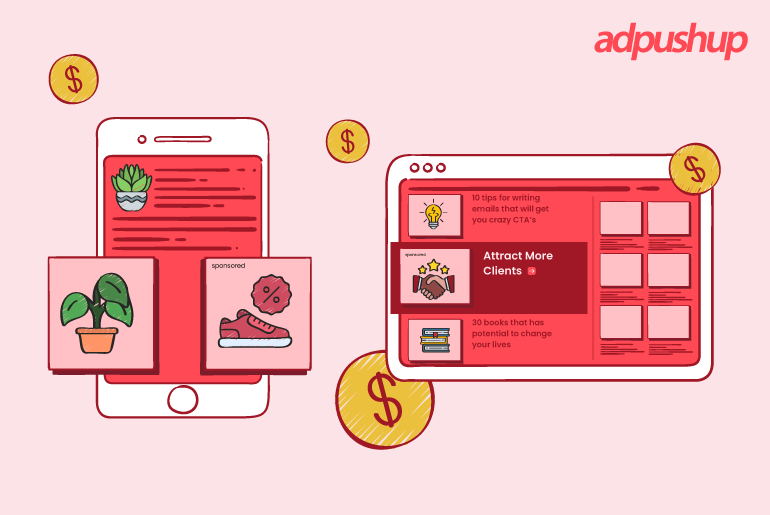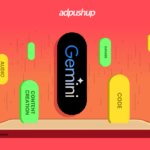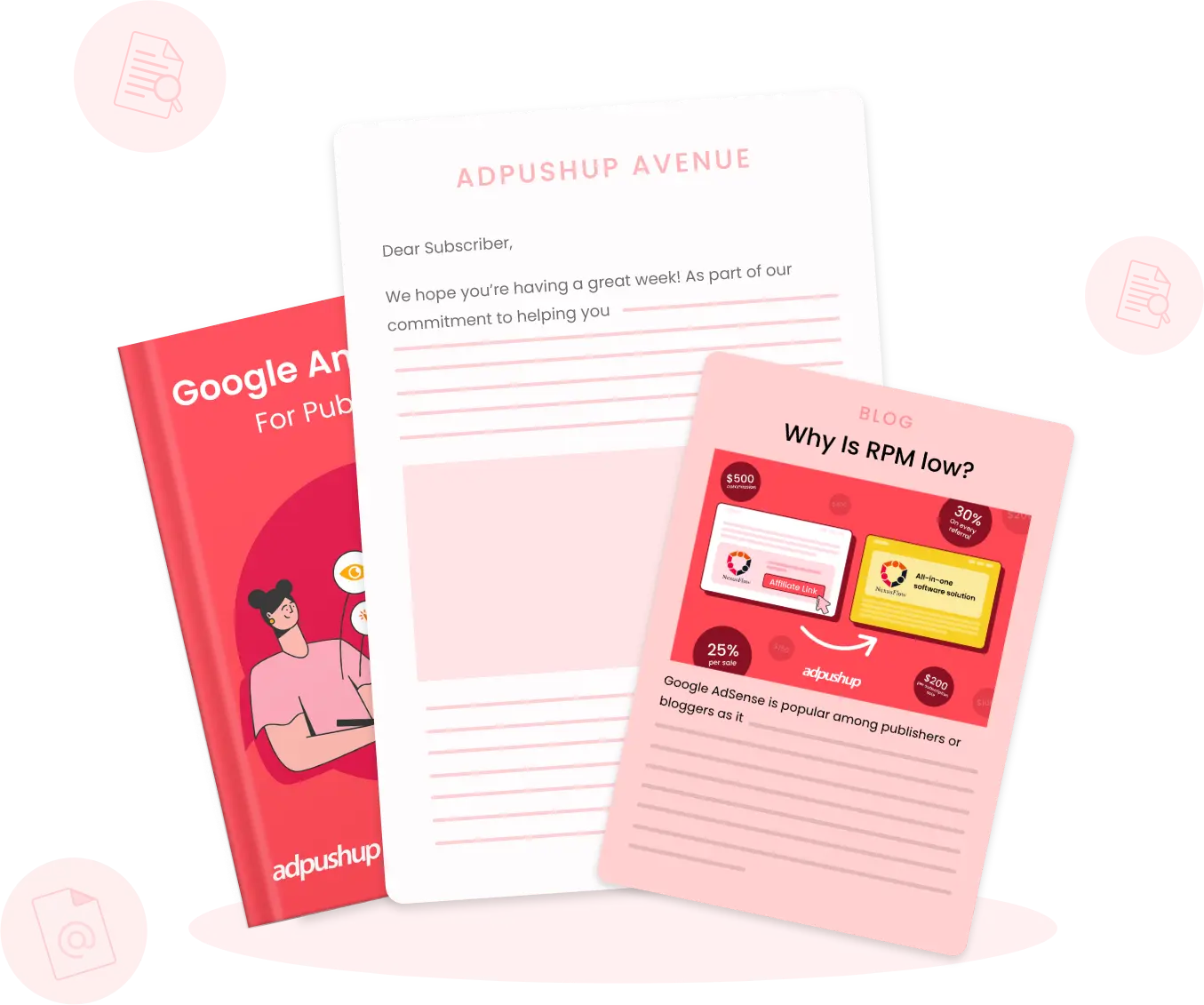Native Advertising is definitely something that is becoming increasingly popular, and if you are looking forward to having a successful ad campaign, it is important that you, too, become abreast of the examples of native ads and how it actually works.
What is Native Advertising?
Native advertising is a form of paid promotion designed to seamlessly blend with the visual and functional aspects of the platform where it appears. The key characteristic of native ads is their integration with the surrounding content, making them appear less like traditional advertisements and more like a natural part of the user experience. These ads are contextually relevant and often mimic the style of non-sponsored content, contributing to a more cohesive and engaging environment.
Unlike disruptive display ads, native advertising aims to provide a non-intrusive experience for users. It takes various forms, including sponsored articles, promoted social media posts, in-feed ads, and more. The success of native advertising lies in its ability to resonate with the target audience, offering content that aligns with user interests while maintaining transparency through clear disclosure labels.
Examples of native advertising include sponsored tweets on Twitter and promoted posts on Instagram. Platforms like news websites and content discovery platforms also utilize native ads, presenting them as recommended articles or content widgets. The ethical inclusion of native ads involves maintaining a balance between integration and transparency, ensuring that users are aware they are viewing sponsored content while still enjoying a seamless and relevant user experience.
Simply put, Native ads are a form of advertising that matches and blends in with the medium it appears on. It can include anything starting from articles and infographics to videos – if the content creator can produce it, corporations can purchase it, and publishers can promote it, they are native ads.
However, the only thing that differentiates it from other advertorials is that it should be able to align with the established editorial tonality and style of the website or app and should also be able to offer the kind of information that the target audience of the website or app would typically expect.
These are the qualities that make it difficult to point out the native ads, as they blend quite well with the organic content of the site. This also becomes easy because there are hardly any guidelines regarding how the publishers should label their native ads, and also, the transparency factor is dealt with by various publications in various ways.
Simple, right? Keep reading for an even better understanding of what native ads are and how you can benefit from using them properly. By the way, here’s a list of some of the best native ad networks out there in case you were looking for that information.
Let’s start with the types of native ads.
Also Read: The 7 Best Native Ad Networks for Online Publishers
Why Does Native Advertising Matter?
Native advertising is immensely effective in building brand relevance and capturing your target audience just the way you intend to. Its primary goal is promoting the services or products of the advertisers in a way that the ad contents fit in a seamless manner in the environment it appears in and also does not disrupt user experience in any way.
Native advertising matters for several reasons, as it addresses key challenges faced by both advertisers and consumers in the digital marketing landscape:
-
Seamless Integration and Improved User Experience
Native ads seamlessly blend with the overall design and content of the platform, creating a more natural and less disruptive experience for users. This non-intrusive approach is crucial in a world where consumers often ignore or actively resist traditional display ads. By fitting seamlessly into the user experience, native advertising can capture attention and deliver messages in a way that feels more organic.
-
Increased Relevance and Engagement
Native ads are typically tailored to match the context and interests of the platform’s audience. This contextual relevance enhances the chances of capturing users’ attention and engagement. By aligning with the surrounding content, native advertising can deliver messages that are more likely to resonate with the target audience, leading to higher click-through rates and better overall campaign performance.
-
Monetization and Revenue Streams
For publishers and app developers, native advertising offers a valuable revenue stream. By integrating sponsored content that aligns with the platform’s style, publishers can monetize their digital properties without compromising the user experience. This is particularly relevant for free apps and online platforms that rely on advertising as a primary source of income.
-
Adapting to Changing Consumer Behavior
As consumers become more sophisticated and discerning, traditional advertising methods become less effective. Native advertising acknowledges and adapts to this shift by providing a more personalized and user-centric approach. By delivering content that seamlessly fits into users’ online activities, native ads have the potential to cut through ad fatigue and foster positive brand interactions.
-
Cross-Platform Consistency
Native ads can be adapted to different platforms and devices while maintaining a consistent look and feel. This flexibility allows advertisers to reach audiences across various channels, ensuring a cohesive brand message. Whether on social media, news websites, or content discovery platforms, native advertising enables a unified brand presence.
How Do You Spot Native Advertising?
Spotting native advertising can sometimes be challenging because these ads are designed to seamlessly blend with the surrounding content. However, there are a few cues and indicators that can help you identify native advertising:
-
Disclosure Labels
Ethical native advertising includes clear disclosure labels or markings to indicate that the content is sponsored or promoted. Look for phrases like “sponsored,” “promoted,” or “ad” placed near or within the content. These labels are often required by platforms to maintain transparency.
-
Different Design Elements
While native ads aim to mimic the design of regular content, there might be subtle differences. Pay attention to elements like font, colors, or a small logo that indicates the content is sponsored. Native ads often have a slightly different visual style to help them stand out to users who are observant.
-
Unusually High Quality or Polished Content
Native advertising often involves well-produced and high-quality content. If you notice content that seems exceptionally polished or professional compared to the regular content on the platform, it might be a native ad.
-
Out-of-Context Content
If the content seems out of place or unrelated to the typical theme of the platform, it could be a native ad. Advertisers aim to make their content relevant, but sometimes it may still appear distinct from the regular editorial or user-generated content.
-
Prominent Branding or Logo
Some native ads include a brand’s logo or other branding elements. Keep an eye out for these subtle indicators, as they can reveal the promotional nature of the content.
-
Sponsored Sections or Widgets
On some platforms, native ads are presented in clearly labeled sections or widgets that separate them from the rest of the content. These sections may have titles like “Recommended” or “Sponsored Content.”
-
Language and Tone
Native ads may use a slightly different tone or language compared to regular content. They might include promotional language, calls to action, or marketing messages that differ from the surrounding non-sponsored material.
By being aware of these cues, users can better differentiate between regular content and native advertising, allowing for a more informed and discerning online experience.
Native Advertising vs. Content Marketing
Native advertising and content marketing are related concepts that share similarities but involve distinct approaches to engaging and attracting audiences. In a nutshell, while both native advertising and content marketing aim to engage audiences, native advertising is a paid strategy emphasizing seamless integration, and content marketing is an organic, owned media approach focused on providing valuable content over the long term.
|
Aspect |
Native Advertising |
Content Marketing |
|
Payment Model |
Paid promotion |
Organic, often no explicit payment |
|
Integration |
Seamlessly blends with platform content |
Part of owned media, distinct from ads |
|
Disclosure |
Requires clear labels or markings |
Typically no explicit disclosure |
|
Goal |
Short-term goals, specific campaigns |
Long-term strategy, building relationships |
|
Owned/Earned Media |
Generally considered paid and earned media |
Primarily owned and earned media |
|
Content Format |
Various formats (e.g., articles, social ads, native video ads, etc.) |
Diverse content types (blog, videos, etc.) |
|
Transparency |
Clearly indicates content is sponsored |
Relies on authenticity and value delivery |
|
Storytelling |
Emphasis on fitting within platform context |
Emphasis on brand storytelling and value |
|
SEO Impact |
Less impact on organic search visibility |
Emphasizes SEO for organic search visibility |
|
Longevity |
Part of short-term campaigns |
Part of a long-term, ongoing strategy |
Why Is Native Advertising So Controversial?
Native advertising is controversial for several reasons, primarily stemming from concerns related to transparency and ethics. The seamless integration of native ads with regular content on a platform can lead to a lack of clarity for users, potentially causing them to consume sponsored content without clear disclosure. This perceived deception raises ethical questions about the boundaries between editorial and promotional material. Users may feel manipulated if they discover that the content they engaged with was paid for by advertisers, eroding trust in publishers and platforms.
Another source of controversy is the potential impact on user experience. While native advertising aims to provide a less disruptive experience, poorly executed native ads can still interrupt the natural flow of content and irritate users. If native ads are intrusive or irrelevant, they may contribute to a negative perception of the brand and the platform hosting the content. The focus on seamlessly blending with the surrounding content may also lead to concerns about the quality of the information provided, as advertisers might prioritize promotional aspects over the educational or informative value of the content.
Additionally, the dynamic nature of digital advertising and the evolving landscape of native advertising pose challenges for regulatory bodies. Establishing and enforcing clear guidelines can be difficult, creating an environment where advertisers may push the boundaries of ethical practices. The potential for exploitation, especially in sensitive industries such as health or finance, adds to the controversy. In the context of news websites, the inclusion of native advertising alongside journalistic content raises questions about editorial independence and the credibility of journalism, further contributing to the overall controversy surrounding native advertising. Efforts to address these concerns include clearer disclosure practices, ethical guidelines, and ongoing regulatory developments in the advertising industry.
Common Types of Native Ads
The term “native ad” refers to a large and ever-expanding list of advertisement formats and delivery methods.

Here is a list of the current most common types you will run into.
In-Feed Ad Units
They come integrated into the content, social platform or feeds. They are custom-made to blend really well with the content of the publisher and minimize disruption and obtrusion for the audience. They can be sponsored articles as well as ads designed to appear to be articles and match the content surrounding them.
Search Ads
These are ads that appear at the top of search engine results that appear similar to other results being displayed. The most popular search ads are Google AdWords and Bing Ads.
Recommendation Widgets
When reading an article or viewing other content, you will sometimes see near the content a section with links to related content and pages. These are usually paid advertising spots that guide the visitor to other sites and advertising.
Promoted Listings
These types of ads usually appear on e-commerce sites like Amazon and eBay. They have sponsored product listings that have been paid for by the seller or manufacturer. They appear just like other product listings, but they appear at the top of listings, recommended product listings and other preferred positions.
In-Ads
Contextual text ads like Google AdSense fall in this category of native ads. They are ads that contain advertising related to the content on the page it appears or is related in some way.
There are, of course, many more forms of native ad formats, but the ones discussed above are the most popular types.
Also Read: 7 Future Trends in Native Advertising You Need to Know About
Native Advertising Statistics
Native advertising continues to be a rising star in the digital marketing world, and for good reason. Here are some key statistics that highlight its current and projected success:
Market Growth
The global native advertising market size was valued at USD 97.8 billion in 2022 and is expected to reach USD 216.9 billion by 2028, growing at a compound annual growth rate (CAGR) of 14.2% during the forecast period. This signifies a significant increase in spending on this form of advertising.
Mobile
Mobile devices are leading the charge, with 85% of native ad spending directed towards mobile platforms in 2023. This trend is expected to continue, with mobile native advertising accounting for an even larger share of the market in the coming years.
Engagement and Effectiveness
Native ads have higher click-through rates (CTRs) and engagement rates than traditional display ads. The average CTR for native ads is 0.38% on mobile compared to 0.11% for banner ads. This translates to more clicks and conversions for your advertising budget.
Consumers are also more likely to share native ads with their friends and family, with 32% of respondents in a survey saying they would do so, compared to just 19% for display ads. This word-of-mouth marketing can be incredibly valuable for brands.
Cost and ROI
While native advertising can be more expensive than traditional display ads, it can also offer a higher return on investment (ROI) due to its increased engagement and effectiveness. The average cost per click (CPC) for native ads is between $0.53 and $0.93 on desktop and between $0.21 and $0.63 on mobile.
Video native ads are particularly effective, with CTRs as high as 1.8% and view-through rates of 55%. While these ads may be more expensive to produce, they can be well worth the investment for brands looking to reach a wider audience and generate leads.
Overall, the statistics paint a clear picture of the bright future of native advertising. As consumers continue to tune out traditional ads, brands are turning to native formats to reach them in a more engaging and effective way. So, if you’re not already using native advertising in your marketing strategy, now is the time to start.
Best Examples of Native Ads
Sometimes the best way to understand something is to take a look at it. So let’s do just that. Let’s take a look at some examples of native ads.
1) The Onion – Fun Example of Native Advertising
The Onion, one of the wittiest yet satirical websites on the internet, does quite well when it comes to native ads. Here’s a fun example of the Native ad!

However, in this case, The Onion designed this ad specifically for the client H&R Block instead of Block just publishing their own content on the site. The content and positioning here clearly identify with Native ads, although they may be somewhat different from traditionally sponsored ads.
Here, although the banners have been used as CTA, the original purpose of increasing brand awareness of H&R has been a success and has been possible because of this Native Ad.
2) Forbes – Informational Type of Native Ad

Like others, Forbes has also resorted to a contributor-led model and has started to publish native advertising. This may be considered a great example of native ads as although it has a clearly advertisement-based angle, it also has actual informational content.
3) UPS Infographic – Native Ad Example for Branding

This infographic may not be top-notch in its design, but it does its job alright. This is a great example of native ads considering it’s almost indistinguishable from the original content of Fast company.
The only thing that gives it away is the tine gray tag “Advertisement”, which one can easily miss anyway. The infographic also smartly uses the brand UPS’s colour scheme of brown and yellow, which further enhances brand engagement in a subtle way. It successfully sells UPS’s format of “problem/solution”, which is tried and trusted.
4) BuzzFeed – Paid Native Ad Listings
When viewing the main page of BuzzFeed, look for the yellow “promoted by” boxes. These are paid native ad listings.
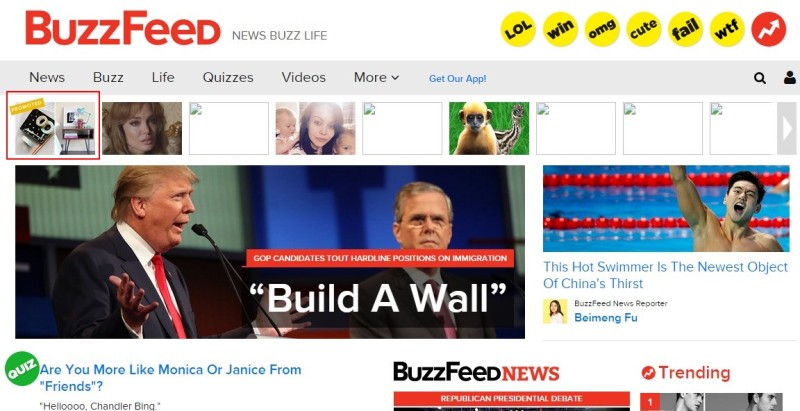
5) New York Times – Native Ad for Brand Recognition
This is a paid post to increase Dell’s brand recognition.
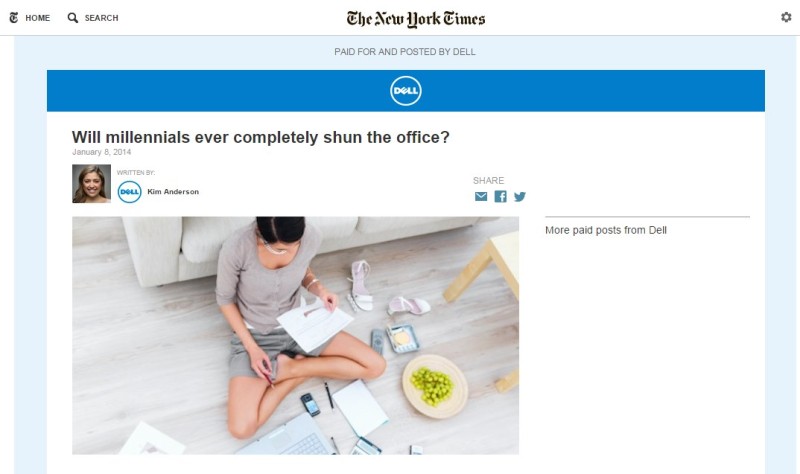
6) Facebook – Sponsored Native Ads
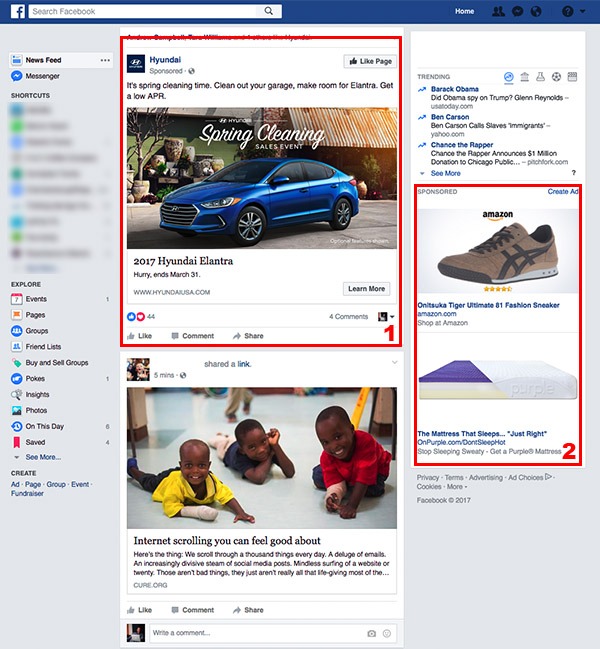
Go scroll through your news feed on Facebook. Notice the sponsored posts that appear directly in your news feed? These are also native ads.
7) Google – Contextual Native Ads
When you search on Google, did you notice the top few search results are actually paid-for placements? These are prime examples of in-search contextual native ads.
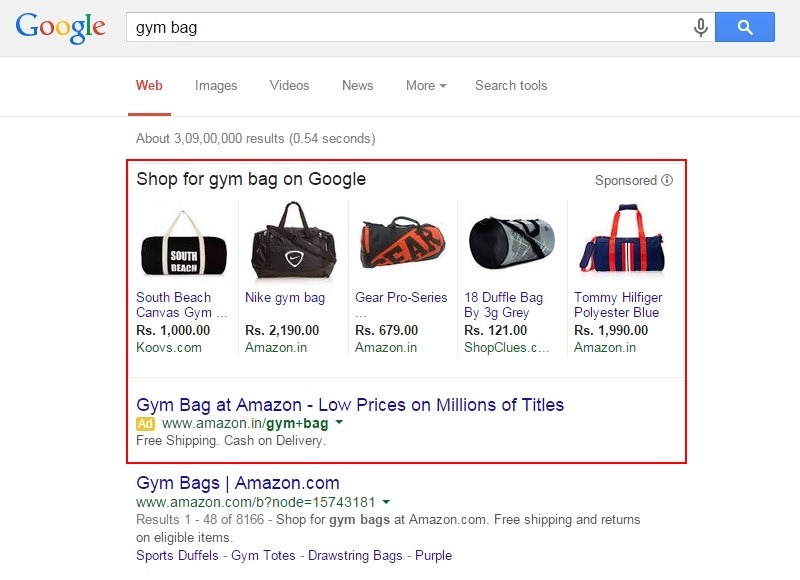
It is obvious that planning as well as executing digital ad campaigns are indeed time-consuming and overwhelming. Here’s how native ads make it easier for you:
-
They are Efficient
-
Say Goodbye to Ad Fatigue
The Profitability of Native Ads
When looking at it from a general point of view, native ads can be considered quite a cost-effective way of promoting your brand and spreading your message. Like all advertising formats, the cost depends on where it is being displayed and how large an audience is.
Now for programmatic native campaigns to be successful, it becomes handy because it lets you optimize the patterns to fit the allocated budget. If the campaign is supposed to be shown on only a premium publishing platform, CPM prices are supposed to be higher than showing the same ads on public forums, for example.
In the case of native ads, the Cost-per-Mille generally remains on the higher side when compared to banner ads.
In the case of a programmatic display campaign, the average CPM prices vary between $0.50 – $4.
Native ad prices can cross this threshold, going as far as $10 or $20.
The high CPM, however, has not affected its popularity and growth. Considering its ability to drive high engagement, people often consider native advertising as a rather cost-efficient part of their marketing mix.
Also Check: How to Optimise Native Ads for Higher Revenue
Why Native Ads Are Becoming Popular Online
Native ads are becoming more and more popular with advertisers due to several developments in human behaviour brought on by past advertising methods and ever-shrinking attention spans.
Viewers have been so inundated with ad banners that now they just mentally block them out. They are becoming blind to them, this phenomenon is aptly called banner blindness.
Some Internet users even run browser plug-ins that remove all the banner advertising from the pages they view. Advertisers are becoming aware of this and are tired of throwing advertising dollars away.
Also, the human attention span has become smaller and smaller over the decades, especially since the advent of the Internet. Advertisers are quickly learning that they only have seconds to grab the attention of a person and have to fight to keep it.
Native advertising aims, and in some cases, effectively manages to solve the above problems. It grabs readers’ attention and gets the advertising message over to them.
Can Native Ads Go too Far?
Many forms of native ads blend in so well with the surrounding content and appear as articles instead of ads to many readers. This can and does cause some confusion and trust issues.
A reader could think he is reading an article or review by a third party when in reality, he is reading an ad written by the seller of the product.
So, the reader is thinking he is reading an unbiased opinion about a product when he is actually reading a highly biased opinion. See what I am getting at?
With the rise in popularity of native ads, the blur between content and advertisements is becoming greater.
This blurring raises the need for proper disclosure, so a reader understands that he is, in fact, reading an ad or sponsored content.
Simply labelling the native ad with a label such as “Advertisement”, “Sponsored”, “Suggested Post”, “Sponsored By”, or “Presented By” could easily disclose to the reader that he is reading a paid advertisement without being intrusive.
Without proper disclosure, a native ad could move into the realm of deception.
Since native advertising can be quite profitable, you will always see some marketers pushing the envelope. Just be careful that you don’t cross that fine line.
Also Read: Native Ads vs Display Ads: What Should A Publisher Choose
Native Ads vs. Display Ads
Display Ads:
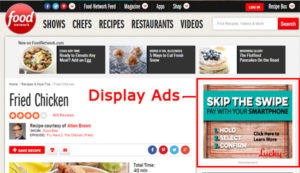
- Display ads are essentially banner ads, which appear in the form of graphics in various shapes and sizes.
- Display ads are often considered effective in the promotion of certain products, brand building as well as retargeting the visitors of the website.
- They are designed to showcase your brand and your product going by the guidelines of the same. Also, thanks to the widespread inventory on a number of websites, they can reach people at whichever place they go to and browse.
- Marketers often act as a very important part of their online advertising strategy.
Native Ads:
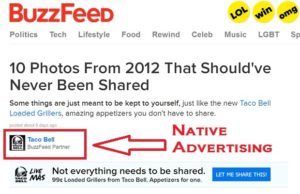
- However, on the other hand, native ads are designed to fit inside the media that they are displayed in.
- They sport an elite, editorial look and appear to be much less hard-selling or obtrusive when compared to banner or display ads.
- While using native ads, brands can go into showcasing their products or services or causes in a little more detailed form.
- The style definitely catches the attention of the viewers, at the same time giving the brands a scope to tell their story, and in a better way at that.
- The average click-through rate is 0.3%, and native ads are actually thus a very useful way of driving traffic to the intended blog, article, website or app.
Conclusion
By now, you should have a pretty good grasp of what native ads are. We’ve covered what native ads are, their types, and covered examples of actual native ads. We then raised the question of whether native ads could go too far.
The bottom line is that native ads work well because they blend into the content around them. A good native ad actually provides useful content or leads the viewer to additional information about the content they are exploring.
A great native ad can entertain and inform as well as sell or bring brand recognition.
The key to writing and designing a successful native ad is to know your audience and the medium the native ad will appear within.
FAQ
Native ads are designed to blend in with the surrounding content and look like editorial content, while traditional ads are more clearly labelled as advertising.
Native ads can take many forms, including in-feed ads, sponsored content, promoted listings, and more.
Native ads are typically priced on a cost-per-thousand (CPM) or cost-per-click (CPC) basis.
Native ads can be effective if they are well-targeted and well-designed. They can be less intrusive and more engaging than traditional forms of advertising, which can lead to higher click-through rates and conversion rates.
Display ads are banner-like ads that are typically placed on the sidebars or header/footer of a website. Native ads are more integrated into the content of the website and are meant to look like the content.

Shubham is a digital marketer with rich experience working in the advertisement technology industry. He has vast experience in the programmatic industry, driving business strategy and scaling functions including but not limited to growth and marketing, Operations, process optimization, and Sales.
